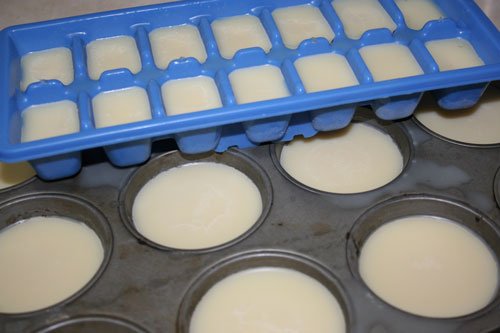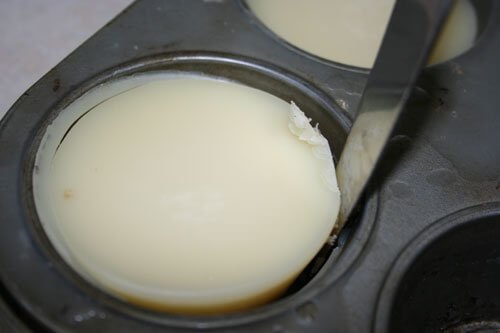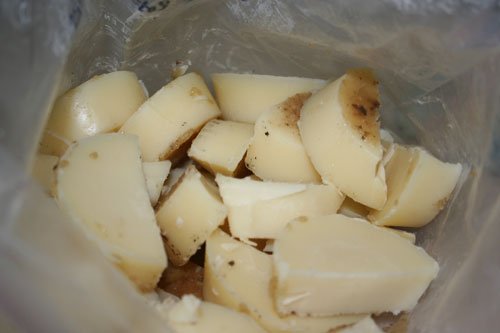Homemade Beef Tallow: A Simple and Convenient Way to Store It

Last year, I was delighted to learn how to render my own beef tallow from all the bones/fatty pieces that came with our side of grass-fed beef.
Just the other week, I picked up a new side of beef and was more eager than ever to whip up some nourishing bone broth, and in particular, to have some beef tallow again for cooking. We have just fallen in love with using this old-fashioned, wholesome fat for making homemade french fries, deep-fried zucchini sticks, and most recently, butternut squash fries. Mmmm!
I wanted to store the tallow in the freezer, the best place for long-term storage as it will eventually go bad in the fridge. I also wanted it to be very accessible and convenient to use in various recipes, in varying amounts.
Here’s what I did:
1. Took all the tallow off the top of my vat of cooled-off beef broth (I let the entire, huge pot sit in my fridge overnight).
2. Put the cooled, hardened tallow into a pot to gently melt it down to liquid, without it getting hot (just slightly warm). I could have strained it at this point to have a clear fat, without any traces of broth in it, but I’m not that picky, so I left it as-is.

3. Poured it into my muffin tin and ice cube tray in even amounts (this is why I didn’t want it too warm- because I was using a plastic tray), and immediately put them both into the freezer.
4. A few hours later, I took a butter knife, gently slipped it between the tallow “muffin” and the tray, and pop! Out it came, just like that. The ice cube tray tallow took a teensy bit more coaxing to come out, but not too much more (I just twisted the tray, then repeatedly banged it on the counter).
5. I knew that the muffin shaped tallow pieces were larger than I would usually need, so I cut each of them in half.
6. Tossed all of the tallow pieces into a large ziploc bag, to be stored in my fridge freezer for easy access!

I’ve used a little bit since I did this earlier in the week, and I love how easy it is to just grab a chunk and keep cooking! I have also found that although the pieces are firm, they can still be easily cut with a sharp knife, if I need an even smaller piece.
This post is part of Fight Back Friday and Real Food Wednesday.





This is a great post. Hopefully it will inspire many to return to the old ways ~smile~.
I’ve only recently found a source of grass fed beef, but I have done what you’re doing. I also save bacon grease (sadly not from pastured pork), although we don’t eat bacon very often. I also save chicken fat from soups and I’ve used it, softened a bit, to make tea biscuits atop chicken pot pie, as well as for frying. We don’t deep fry, but to fry anything else, yes.
.-= Mrs. T´s last blog ..Two Stories =-.
How wonderful to hear beef tallow described as a “wholesome fat”! I get so tired of hearing people putting down deep frying things in animal fat, saying how unhealthy it is. The reality is that it is unhealthy to fry in most vegetable fat, because it’s so unstable and becomes a trans fat in the process of heating it up.
.-= Angela´s last blog ..Distracted by a China Doll =-.
this is interesting. ive never heard of this…always something new to learn. nothing like going back to the old ways. 🙂 tq
Thanks for sharing. I have bags of beef fat from our recent butchering and needed to know what to do with it all.
Mrs. P
Do the foods you cook in tallow leave a film in the roof of your mouth after they start to cool? I noticed that last week when I made potato chips in tallow.
@Barbara Grant,
I would like to know the answer to this question too! Anyone?
@Robin, I just replied to Barbara, “No, I haven’t noticed that they do. In fact, we find that we prefer the beef tallow to most of the other fats that I use!”
@Barbara Grant, No, I haven’t noticed that they do. In fact, we find that we prefer the beef tallow to most of the other fats that I use!
I’ve often wondered about this. The thing is, that I wonder though if its still okay if the meat is not fed organic grains. The best I can do (for now, maybe that will change with both financial wise and accesibility wise) is to get mostly free range, no drug chickens and turkies, but they are also fed some local grains, and to get drug free, local beef (fed some grains, fed some grass, but mainly local grains). I’ve always been told that pesticides etc. get concentrated in the fat. So I do know for sure that the grains these animals are fed are not guaranteed to be pesticide free, so that makes me question the use of the fat. Its not just a question of finding someone who I can get better meat from- this really is right now the best we can do with our money and also accesibility in our area.
Would you still use the fat in this circumstance?
@Nola, That’s why you go with Grass fed, not grain-fed CAFO garbage! 🙂
I LOVE this post! I’m learning so much!! So frying is okay? Hon, as a southerner, you know that’s magic to my ears…fried okra, where art thou? It’s been so long since fried chicken has graced this house…might these beloved foods be an option again? It doesn’t seem like summer without fried chicken, potato salad, watermelon and cold ice tea on a hot afternoon….okay…now I’m hungry (:
There’s so much conflicting info around… I’m so enjoying getting back to my roots with the old ways of preparing food, the whole food way. Thank you so much for the tips and info!! XOXO
.-= Michele´s last blog ..How Local Honey Can Help During Allergy Season =-.
Do you know how long beef tallow will last in the fridge? That’s where I’ve been storing mine, but maybe I should move it to the freezer.
@chanelle, In my experience, about a month, but I’ve only stored it that way once and I don’t really remember exactly. That’s why I decided to freeze mine this time.
Anyone else know how long it lasts in the fridge?
I don’t know about beef tallow, but I stored bear tallow in the fridge for about 6 months, (as far as my very sensitive nose could tell), it never went rancid
I’ve stored mine in glass for about 6 months on the lower shelf all the way in the back of my refrigerator. I do my best to clean out the “impurities” as to not promote mold growth. Leaving the impurities, such as some of the meat fragments, makes the tallow/lard/bacon grease go bad within 2 months, this has happen to me several times. If you notice a tiny amount of mold growth then you can remove that portion then bring your rendered oil to high heat and still use it for several weeks. In short, about 6 months in the fridge. Any longer than that, you’ll need to freeze it.
I LOVE this post! I’m learning so much!! So frying is okay? Hon, as a southerner, you know that’s magic to my ears…fried okra, where art thou? It’s been so long since fried chicken has graced this house…might these beloved foods be an option again? It doesn’t seem like summer without fried chicken, potato salad, watermelon and cold ice tea on a hot afternoon….okay…now I’m hungry (:
There’s so much conflicting info around… I’m so enjoying getting back to my roots with the old ways of preparing food, the whole food way. Thank you so much for the tips and info!! XOXO
.-= Michele´s last blog ..How Local Honey Can Help During Allergy Season =-.
@Michelle, Yes, believe it or not, frying IS ok! Isn’t that a beautiful thing??? Enjoy yourself some fried okra!
Do you know anything about re-using tallow? I’ve heard that after deep-frying with it, it can be filtered and reused. I don’t know any details though. How many times can you reuse it?
@Sue, I’m not sure how many times you can reuse it, but I have used mine 2-3 times after deep frying with it.
Please forgive my ignorance ahead of time, but is tallow and fat the same thing? How do you know what is what?
@RG, Yes, the tallow is just the proper name for beef fat. I separate the fat by making bone broth (soaking and then boiling the bones for a long time) and then when I’m done I put it in the fridge overnight. The fat separates and rises to the top. In the morning, there is an obvious layer of tallow on the top, and all the broth below, and because it has hardened it’s easy to remove the fat completely.
Hi there, I just bought a frozen container of tallow because I haven’t found a good beef bone source yet. The problem is that it’s 16 oz and I’m afraid that it will go rancid before I use it all. Any suggestions? Thanks!
@Clleen, If you keep it frozen, it should last for a long time. I keep my homemade tallow frozen and just take out small amounts when I need it (I freeze it in ice cube trays so that I have small pieces) and it’s still good after more than 6 months.
@Stephanie @ Keeper of the Home,
Storage: Lard and Beef Fat
— The primary consideration for storage is preventing odors from contaminating the tallow or lard.
Mason jars with a sealing type lid (doesn’t need to be vacuum sealed) are ideal.
Tallow and lard do not go rancid, they will store for years in a dark relatively cool area.
My brother bought a farm in 1962 and never occupied the old farm house which stood empty all these years. In 2010 in the basement we discovered three 5 gallon crocks of lard. Removing a layer of paraffin wax the lard looked to be in perfect condition, no spoilage of any kind. Being that it had been in a musty basement for over fifty years it would have probably acquired an off taste despite being sealed with wax, but the fact that it was in perfect condition demonstrates your storage concerns should be primarily geared to keep your fat from absorbing off odors.
I can remember my mother keeping her working crock of lard behind the kitchen door covered just with the normal rather loose fitting crock lid. She’d just grab a gob the size her project called for with her bare hand (a clean hand of course) and be incorporating it into her recipe within seconds. She baked 10 loaves bread every Saturday morning and lard was an ingredient, several quick handfuls of lard and she was rubbing it into the flour.
That was common backfat lard, pies however were special, kidney lard (leaf lard) was reserved for pie crusts simply because it produced the finest and flakiest crusts.
Greetings,
I came across this as I was wondering what to do with all my “Elk butter” as I have been calling it. I just used some cubes on top of a potato and onion gratin rather than butter–why not? The elk broth I got from 2 legs is the richest stuff I’ve made yet: there was a solid three inches of tallow that rose to the top after boiling the bones. I think it was a healthy animal! I’m going to try your muffin pan method for storage. Thanks for the tip!
Can you also do the same thing for pork fat?
I use it quite a bit for sauteeing – I just throw a frozen chunk into the wok or skillet, let as much as I need melt, then pick up the chunk and pop it back into it’s container and into the freezer. Very quick and easy.
Hi.. Pardon my ignorance because im new to this.. Whenever i make bone broth i always put them in the fridge to cool so i can remove and discard the fat that floats and forms on top. So i was bewildered when i read this blog that puts a lot of emphasis on recovering the ‘fat’ instead of discarding it..
Mu question or rather concern is: wont the tallow clog my arteries?
Because technically it is solidified oil or lard
Hey Sonny, get a book called Nourishing Traditions. It will blow your mind and answer all your questions.
Yes, animal fat can actually be very good for you!
What’s the difference between what you do and just taking the hardened fat off the broth and putting it in a container. Why remelt it?
You heat it because you want to remove all the water from the fat before storage.
Oooh, just came upon your website and fell in love. Can’t wait to check out more of it. Thanks so much for the info on tallow (that’s what initially brought me to your site – I was wondering what to do with the layer of fat on my homemade beef broth ;>).